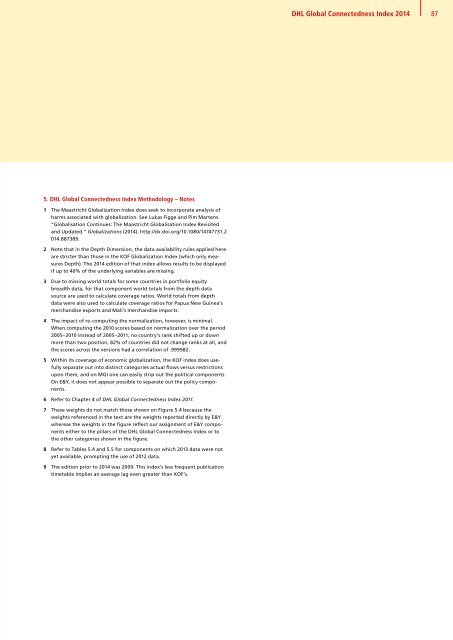DHL Global Connectedness Index 2014
DHL Global Connectedness Index 2014
DHL Global Connectedness Index 2014
- No tags were found...
You also want an ePaper? Increase the reach of your titles
YUMPU automatically turns print PDFs into web optimized ePapers that Google loves.
<strong>DHL</strong> <strong>Global</strong> <strong>Connectedness</strong> <strong>Index</strong> <strong>2014</strong><br />
87<br />
5. <strong>DHL</strong> <strong>Global</strong> <strong>Connectedness</strong> <strong>Index</strong> Methodology – Notes<br />
1 The Maastricht <strong>Global</strong>ization <strong>Index</strong> does seek to incorporate analysis of<br />
harms associated with globalization. See Lukas Figge and Pim Martens.<br />
“<strong>Global</strong>isation Continues: The Maastricht <strong>Global</strong>isation <strong>Index</strong> Revisited<br />
and Updated.” <strong>Global</strong>izations (<strong>2014</strong>). http://dx.doi.org/10.1080/14747731.2<br />
014.887389.<br />
2 Note that in the Depth Dimension, the data availability rules applied here<br />
are stricter than those in the KOF <strong>Global</strong>ization <strong>Index</strong> (which only measures<br />
Depth). The <strong>2014</strong> edition of that index allows results to be displayed<br />
if up to 40% of the underlying variables are missing.<br />
3 Due to missing world totals for some countries in portfolio equity<br />
breadth data, for that component world totals from the depth data<br />
source are used to calculate coverage ratios. World totals from depth<br />
data were also used to calculate coverage ratios for Papua New Guinea’s<br />
merchandise exports and Mali’s merchandise imports.<br />
4 The impact of re-computing the normalization, however, is minimal.<br />
When computing the 2010 scores based on normalization over the period<br />
2005–2010 instead of 2005–2011, no country’s rank shifted up or down<br />
more than two position, 82% of countries did not change ranks at all, and<br />
the scores across the versions had a correlation of .999982.<br />
5 Within its coverage of economic globalization, the KOF index does usefully<br />
separate out into distinct categories actual flows versus restrictions<br />
upon them, and on MGI one can easily strip out the political components.<br />
On E&Y, it does not appear possible to separate out the policy components.<br />
6 Refer to Chapter 4 of <strong>DHL</strong> <strong>Global</strong> <strong>Connectedness</strong> <strong>Index</strong> 2011.<br />
7 These weights do not match those shown on Figure 5.4 because the<br />
weights referenced in the text are the weights reported directly by E&Y<br />
whereas the weights in the figure reflect our assignment of E&Y components<br />
either to the pillars of the <strong>DHL</strong> <strong>Global</strong> <strong>Connectedness</strong> <strong>Index</strong> or to<br />
the other categories shown in the figure.<br />
8 Refer to Tables 5.4 and 5.5 for components on which 2013 data were not<br />
yet available, prompting the use of 2012 data.<br />
9 The edition prior to <strong>2014</strong> was 2009. This index’s less frequent publication<br />
timetable implies an average lag even greater than KOF’s.





